There are three kinds of rocks: igneous, sedimentary, and metamorphic.
Igneous rocks form when molten rock (magma or lava) cools and solidifies.
Sedimentary rocks originate when particles settle out of water or air, or by precipitation of minerals from water. They accumulate in layers.
Metamorphic rocks result when existing rocks are changed by heat, pressure, or reactive fluids, such as hot, mineral-laden water. Most rocks are made of minerals containing silicon and oxygen, the most abundant elements in the Earth’s crust.

Igneous rocks
Some form below Earth's surface. Some form on or above Earth's surface. We describe these two basic types:
Intrusive igneous rocks crystallize below Earth's surface, and the slow cooling that occurs there allows large crystals to form. Examples of intrusive igneous rocks are: diabase, diorite, gabbro, granite, pegmatite, and peridotite.
Extrusive igneous rocks erupt onto the surface, where they cool quickly to form small crystals. Some cool so quickly that they form an amorphous glass. These rocks include: andesite, basalt, dacite, obsidian, pumice, rhyolite, scoria, and tuff.
Here are some common igneous rock types:
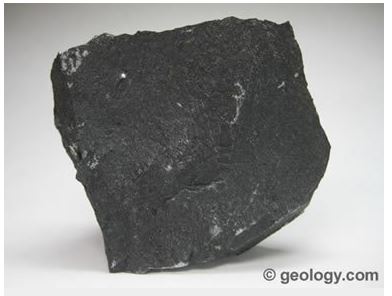 Basalt is a fine-grained, dark-colored extrusive igneous rock composed mainly of plagioclase and pyroxene. | 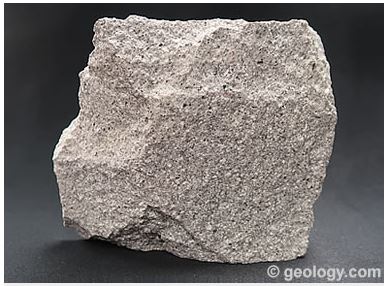 Dacite is a fine-grained, extrusive igneous rock that is usually light in color. It has a composition that is intermediate between rhyolite and andesite. |
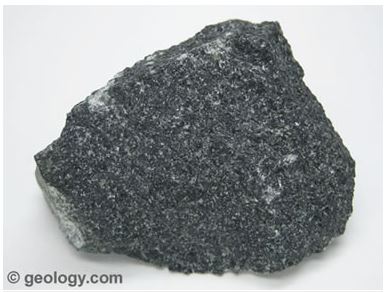 Diabase is an intrusive igneous rock composed mostly of plagioclase feldspar and pyroxene minerals. The grains in diabase are larger than those in basalt but smaller than those in gabbro. Diabase is used in the construction industry as trap rock or dimension stone. When the diabase contains colorful labradorite crystals, it makes an especially nice architectural stone | 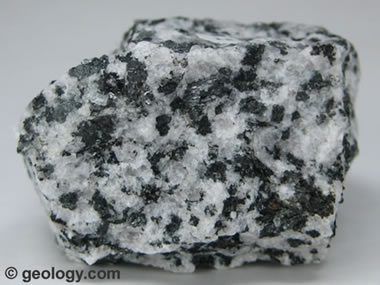 Diorite is a coarse-grained, intrusive igneous rock that contains a mixture of feldspar, pyroxene, hornblende, and sometimes quartz. The specimen shown above is about two inches (five centimeters) across. |
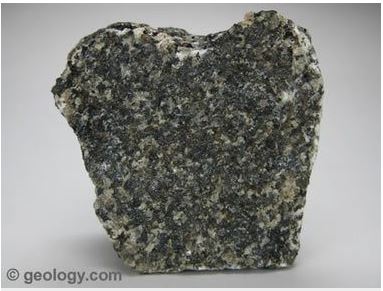 Gabbro is a coarse-grained, dark-colored, intrusive igneous rock that contains feldspar, pyroxene, and sometimes olivine. |  Granite is a coarse-grained, light-colored, intrusive igneous rock that contains mainly quartz, feldspar, and mica minerals. |
 Obsidian is a dark-colored volcanic glass that forms from the very rapid cooling of molten rock material. It cools so rapidly that crystals do not form. | 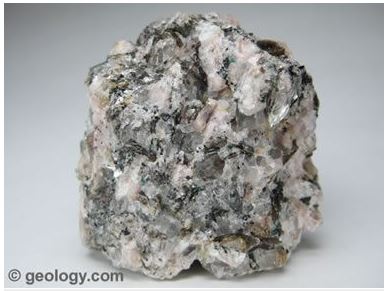 Pegmatite is a light-colored, extremely coarse-grained intrusive igneous rock. It forms near the margins of a magma chamber during the final phases of magma chamber crystallization. It often contains rare minerals that are not found in other parts of the magma chamber. |
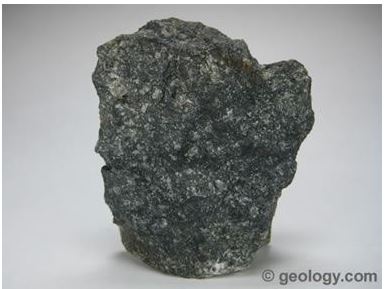 Peridotite is a coarse-grained intrusive igneous rock that is composed almost entirely of olivine. It may contain small amounts of amphibole, feldspar, quartz, or pyroxene. |  Pumice is a light-colored vesicular igneous rock. It forms through very rapid solidification of a melt. The vesicular texture is a result of gas trapped in the melt at the time of solidification. |
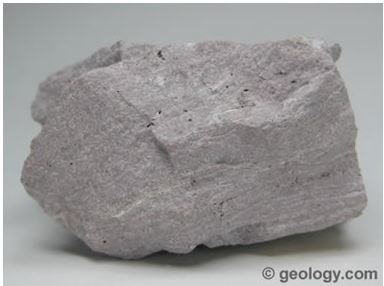 Rhyolite is a light-colored, fine-grained, extrusive igneous rock that typically contains quartz and feldspar minerals. | 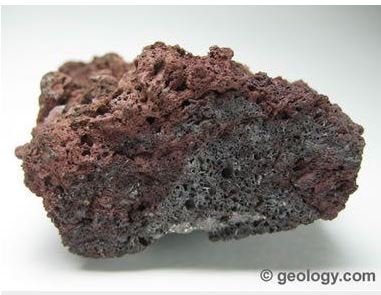 Scoria is a dark-colored, vesicular, extrusive igneous rock. The vesicles are a result of trapped gas within the melt at the time of solidification. It often forms as a frothy crust on the top of a lava flow or as material ejected from a volcanic vent and solidifying while airborne. |
| 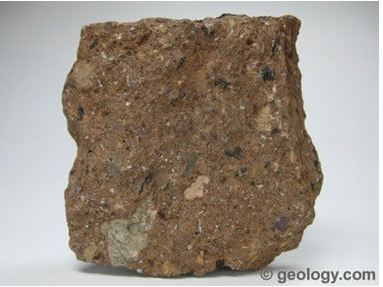 Welded Tuff is a rock that is composed of materials that were ejected from a volcano, fell to Earth, and then lithified into a rock. It is usually composed mainly of volcanic ash and sometimes contains larger size particles such as cinders. |
Sedimentary rocks
There are three basic types of sedimentary rocks:Clastic sedimentary rocks form from the accumulation and lithification of mechanical weathering debris. Examples include: breccia, conglomerate, sandstone, siltstone, and shale.
Chemical sedimentary rocks form when dissolved materials preciptate from solution. Examples include: chert, some dolomites, flint, iron ore, limestones, and rock salt.
Organic sedimentary rocks form from the accumulation of plant or animal debris. Examples include: chalk, coal, diatomite, some dolomites, and some limestones.
Here are some common sedimentary rock types:
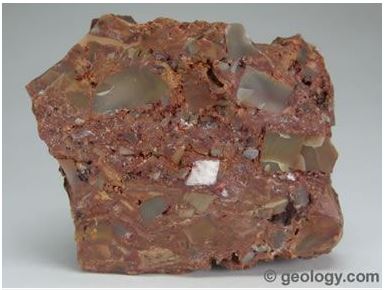 Breccia is a clastic sedimentary rock that is composed of large (over two-millimeter diameter) angular fragments. The spaces between the large fragments can be filled with a matrix of smaller particles or a mineral cement which binds the rock together. | 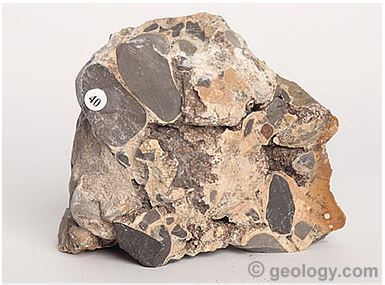 Caliche is found in arid or semiarid climates around the world. It forms when rock fragments and sediment particles are cemented together by mineral matter, usually calcium carbonate, that precipitates and hardens between the particles. Over time, caliche can become very dense and durable, which explains why it is also called hardpan, calcrete, and duricrust. Some people might call it a puddingstone. |
 Chalk is a type of limestone made up of the microscopic calcium carbonate shells of marine organisms. Chalk is soft, friable, porous, and effervesces vigorously in contact with hydrochloric acid. Because it is very porous, subsurface chalk units can serve as reservoirs for oil and natural gas. | 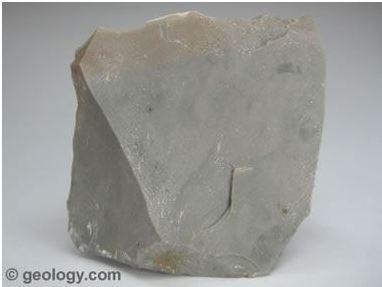 Chert is a microcrystalline or cryptocrystalline sedimentary rock material composed of silicon dioxide (SiO2). It occurs as nodules and concretionary masses, and less frequently as a layered deposit. It breaks with a conchoidal fracture, often producing very sharp edges. Early people took advantage of how chert breaks and used it to fashion cutting tools and weapons. |
 Coal is an organic sedimentary rock that forms mainly from plant debris. The plant debris usually accumulates in a swamp environment. Coal is combustible and is often mined for use as a fuel. | 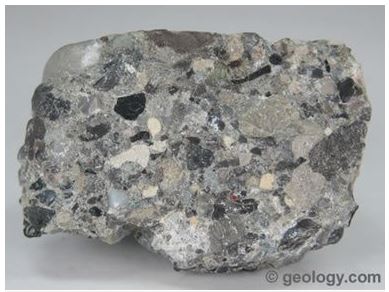 Conglomerate is a clastic sedimentary rock that contains large (greater than two millimeters in diameter) rounded particles. The space between the pebbles is generally filled with smaller particles and/or a chemical cement that binds the rock together. |
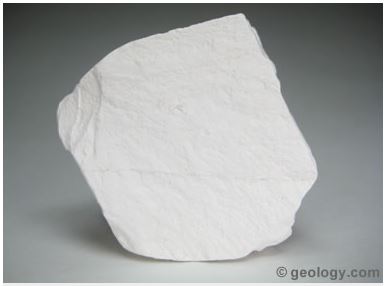 Diatomite is a sedimentary rock with many uses. It is made up of the siliceous skeletal remains of diatoms, which are tiny single-celled algae. Diatomite is crushed into a powder known as "diatomaceous earth". It is lightweight, porous, relatively inert, and has a small particle size along with a large surface area. These properties make diatomaceous earth useful as a filtration media, a lightweight aggregate, a lightweight filler, an effective absorbent, and more. | 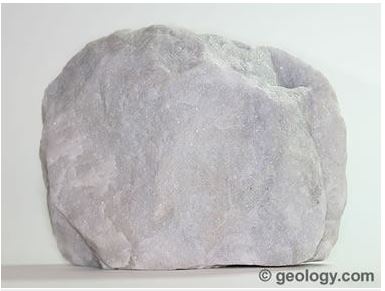 Dolomite (also known as "dolostone" and "dolomite rock") is a chemical sedimentary rock that is very similar to limestone. It is thought to form when limestone or lime mud is modified by magnesium-rich ground water. |
 Flint is a hard, tough, chemical or biochemical sedimentary rock that breaks with a conchoidal fracture. It is a form of microcrystalline quartz that is typically called “chert” by geologists. It often forms as nodules in sedimentary rocks such as chalk and marine limestones. | 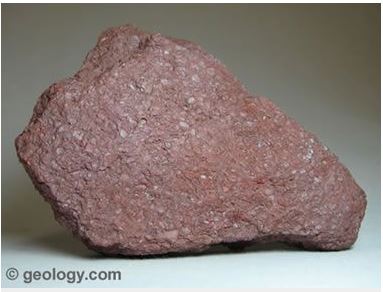 Iron Ore is a chemical sedimentary rock that forms when iron and oxygen (and sometimes other substances) combine in solution and deposit as a sediment. Hematite (shown above) is the most common sedimentary iron ore mineral. |
 Limestone is a rock that is composed primarily of calcium carbonate. It can form organically from the accumulation of shell, coral, algal, and fecal debris. It can also form chemically from the precipitation of calcium carbonate from lake or ocean water. Limestone is used in many ways. Some of the most common are: production of cement, crushed stone, and acid neutralization. | 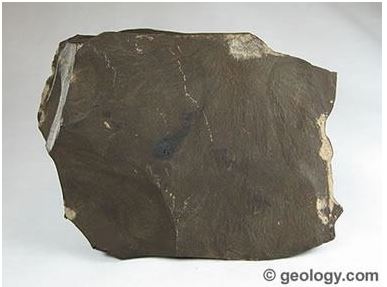 Oil Shale is a rock that contains significant amounts of organic material in the form of kerogen. Up to 1/3 of the rock can be solid organic material. Liquid and gaseous hydrocarbons can be extracted from the oil shale, but the rock must be heated and/or treated with solvents. This is usually much less efficient than drilling rocks that will yield oil or gas directly into a well. The processes used for hydrocarbon extraction also produce emissions and waste products that cause significant environmental concerns. |
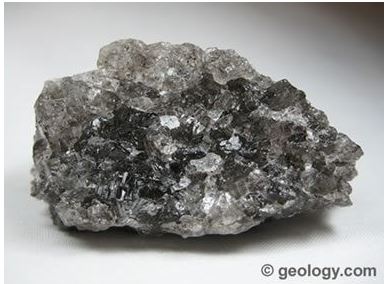 Rock Salt is a chemical sedimentary rock that forms from the evaporation of ocean or saline lake waters. It is also known by the mineral name "halite." It is rarely found at Earth's surface, except in areas of very arid climate. It is often mined for use in the chemical industry or for use as a winter highway treatment. Some halite is processed for use as a seasoning for food. |  Sandstone is a clastic sedimentary rock made up mainly of sand-size (1/16 to 2 millimeter diameter) weathering debris. Environments where large amounts of sand can accumulate include beaches, deserts, flood plains, and deltas. |
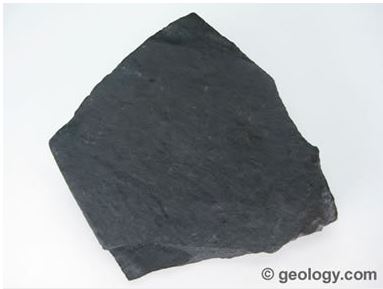 Shale is a clastic sedimentary rock that is made up of clay-size (less than 1/256 millimeter in diameter) weathering debris. It typically breaks into thin flat pieces. | 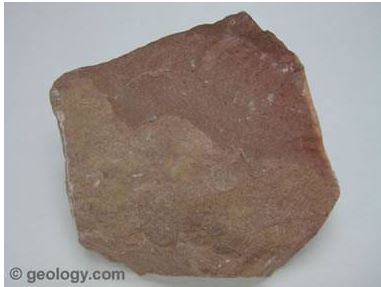 Siltstone is a clastic sedimentary rock that forms from silt-size (between 1/256 and 1/16 millimeter diameter) weathering debris. |
Metamorphic Rocks
Metamorphic rocks have been modified by heat, pressure, and chemical processes, usually while buried deep below Earth's surface. Exposure to these extreme conditions has altered the mineralogy, texture, and chemical composition of the rocks.
There are two basic types of metamorphic rocks:
Foliated metamorphic rocks have a layered or banded appearance that is produced by exposure to heat and directed pressure. Examples of foliated rocks include: gneiss, phyllite, schist, and slate.
Non-foliated metamorphic rocks do not have a layered or banded appearance. Examples of nonfoliated rocks include: hornfels, marble, novaculite, quartzite, and skarn.
Here are some common types of metamorphic rocks:
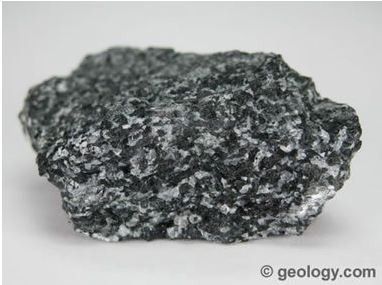 Amphibolite is a non-foliated metamorphic rock that forms through recrystallization under conditions of high viscosity and directed pressure. It is composed primarily of hornblende (amphibole) and plagioclase, usually with very little quartz. | 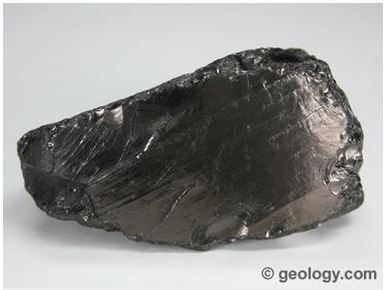 Anthracite is the highest rank of coal. It has been exposed to enough heat and pressure that most of the oxygen and hydrogen have been driven off, leaving a high-carbon material behind. It has a bright, lustrous appearance and breaks with a semi-conchoidal fracture. It is often referred to as "hard coal"; however, this is a layman's term and has little to do with the hardness of the rock. |
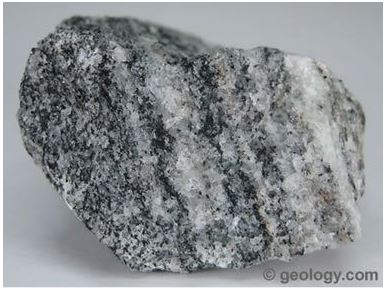 Gneiss is a foliated metamorphic rock that has a banded appearance and is made up of granular mineral grains. It typically contains abundant quartz or feldspar minerals. | 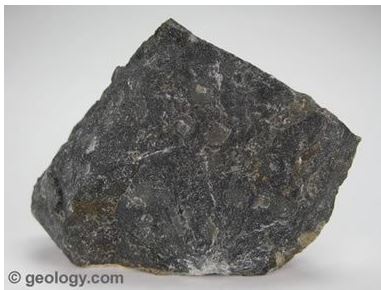 Hornfels is a fine-grained nonfoliated metamorphic rock with no specific composition. It is produced by contact metamorphism. Hornfels is a rock that was "baked" while near a heat source such as a magma chamber, sill, or dike. |
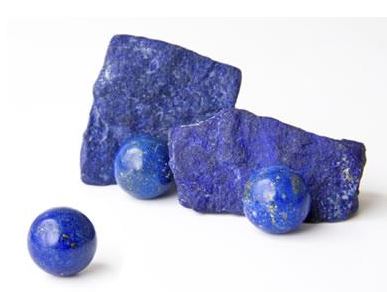 Lapis Lazuli, the famous blue gem material, is actually a metamorphic rock. Most people are surprised to learn that, so we added it to this photo collection as a surprise. Blue rocks are rare, and we bet that it captured your eye. The round objects in the photo are lapis lazuli beads about 9/16 inch (14 millimeters) in diameter. |  Marble is a non-foliated metamorphic rock that is produced from the metamorphism of limestone or dolostone. It is composed primarily of calcium carbonate |
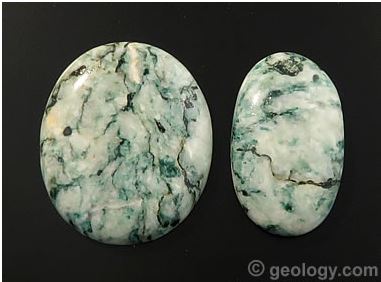 Mariposite is a word that has been used in many ways. It can refer to green mica minerals, or metamorphic rocks that contain enough green mica to impart a green color. Gold prospectors learned that gold could be found in areas where these green rocks were present. This is because mariposite is an ore of gold. | 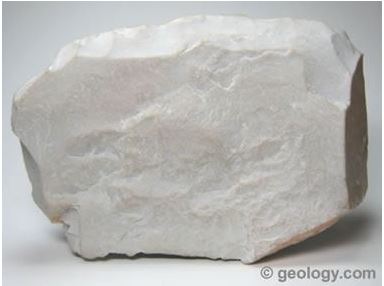 Novaculite is a dense, hard, fine-grained, siliceous rock that breaks with a conchoidal fracture. It forms from sediments deposited in marine environments where organisms such as diatoms (single-celled algae that secrete a hard shell composed of silicon dioxide) are abundant in the water. |
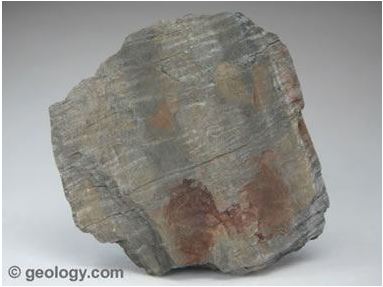 Phyllite is a foliated metamorphic rock that is made up mainly of very fine-grained mica. The surface of phyllite is typically lustrous and sometimes wrinkled. It is intermediate in grade between slate and schist. | 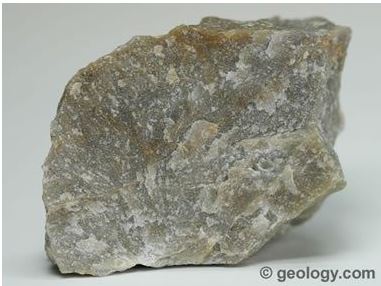 Quartzite is a non-foliated metamorphic rock that is produced by the metamorphism of sandstone. It is composed primarily of quartz. |
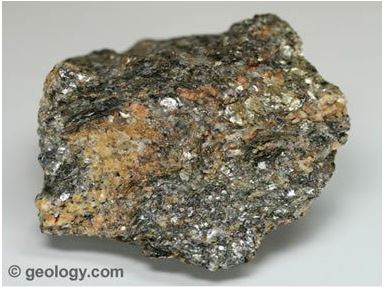 Schist is a metamorphic rock with well-developed foliation. It often contains significant amounts of mica which allow the rock to split into thin pieces. It is a rock of intermediate metamorphic grade between phyllite and gneiss. The specimen shown above is a "chlorite schist" because it contains a significant amount of chlorite. | 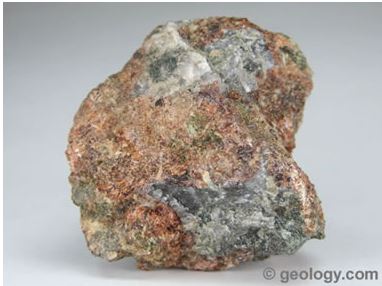 Skarn is a rock characterized by its formation rather than its mineral composition. It often forms when carbonate rocks near a magma body are altered by contact metamorphism and metasomatism. Various minerals, gems, and even precious metals can sometimes be found in skarn. |
 Slate is a foliated metamorphic rock that is formed through the metamorphism of shale. It is a low-grade metamorphic rock that splits into thin pieces. | 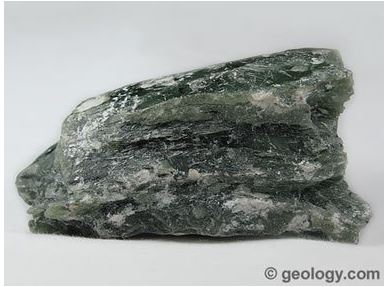 Soapstone is a metamorphic rock that consists primarily of talc with varying amounts of other minerals such as micas, chlorite, amphiboles, pyroxenes, and carbonates. It is a soft, dense, heat-resistant rock that has a high specific heat capacity. These properties make it useful for a wide variety of architectural, practical, and artistic uses. |
References:
https://geology.com
https://www.amnh.org
https://www2.tulane.edu
http://www.galleries.com
https://australian.museum

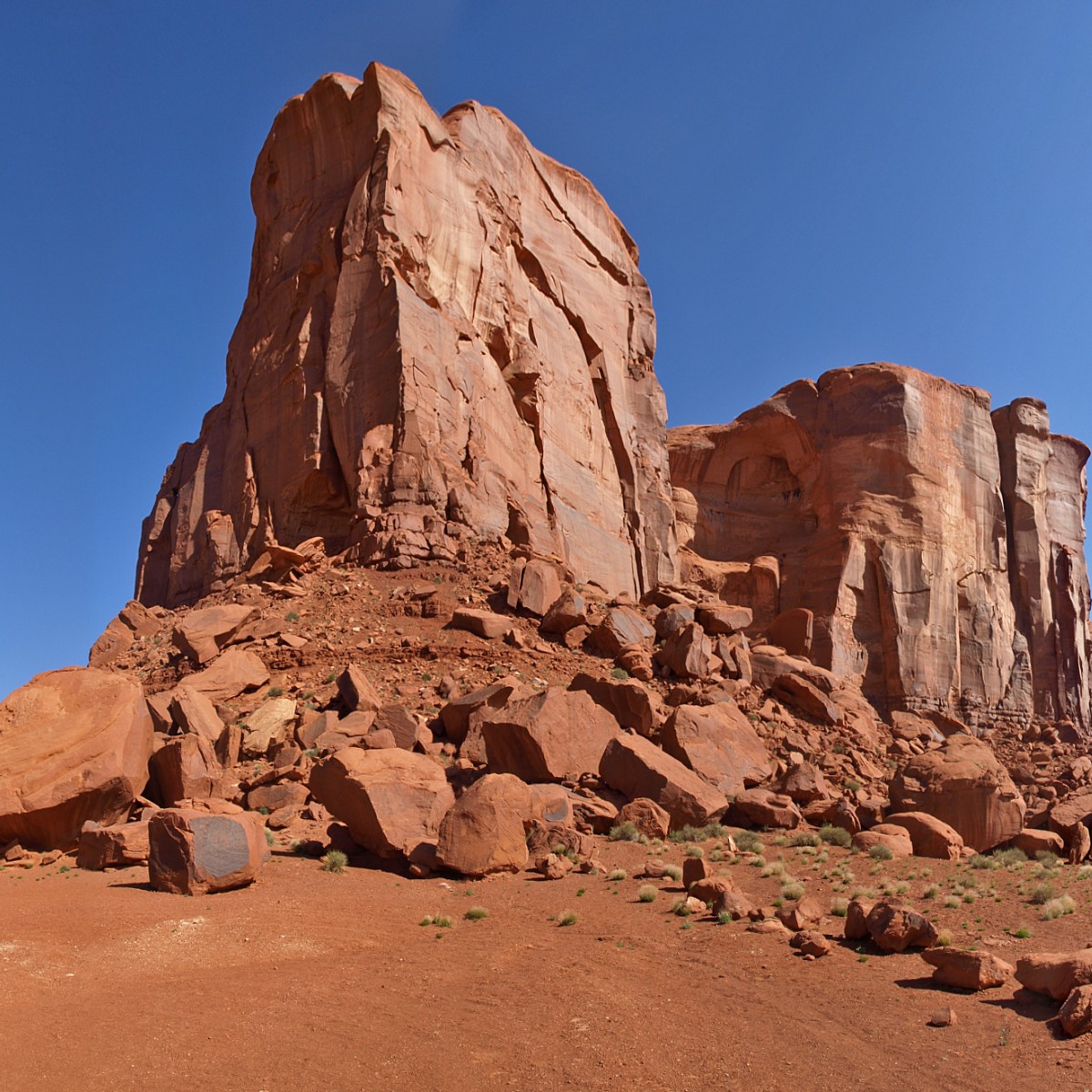
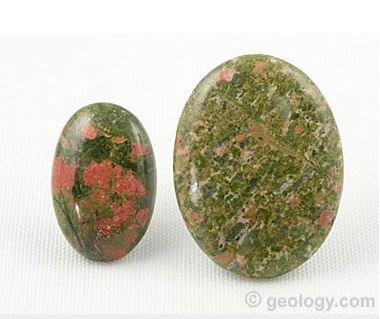 Unakite is a colorful rock composed of green epidote and pink orthoclase. It is formed when granite, an igneous rock, is metamorphosed by hydrothermal activity. Attractive pieces of unakite are often used to make cabochons, tumbled stones, small sculptures, and other lapidary items. It is named after the Unaka Mountains of eastern Tennessee.
Unakite is a colorful rock composed of green epidote and pink orthoclase. It is formed when granite, an igneous rock, is metamorphosed by hydrothermal activity. Attractive pieces of unakite are often used to make cabochons, tumbled stones, small sculptures, and other lapidary items. It is named after the Unaka Mountains of eastern Tennessee.